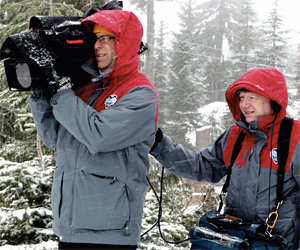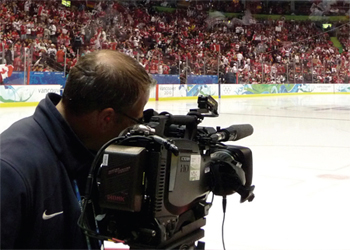Olympics: Simplified and Optimized
VANCOUVER
In many ways this was "Olympics 3.1" for NBC's seasoned Olympics broadcast team, reasons David Mazza, NBC Olympics senior vice president of engineering.
The network's split facility broadcast of the Centennial Olympic Games from Atlanta (and New York) in 1996 was "Olympics 1.0," for the Peacock Network, just setting off on a multiple Games journey.
At the 2000 Olympics in Sydney, the debut of the transportable, storeable "Racks in a Box"(RIBs) infrastructure was 2.0. The dual challenge of going completely HD and managing a massive new media effort made Beijing clearly Olympics 3.0.

NBC cameraman Ken Cavelli and A2 Perry Clark Vancouver saw the network learn from the successes of Beijing. "This time we perfected it, simplified it, optimized it and made it easier to work with so, yes, we're in a .1 release," said Mazza in an interview the day before closing ceremonies.
In large part, this incrementalism is a reflection of the short transition between an August Summer Games and a February Winter Games—the 17 months or so just isn't enough time to make big changes. And Vancouver did not require a big leap into new media or HD as in Beijing.
Another factor reigning in big plans was an economic climate radically different than the Beijing Games, which had taken place just one month before the economic nosedive of 2008 began.
Indeed, if technical refinement was one theme of NBC's coverage, "doing more with less" was another. Vancouver was an Olympics that NBC was anticipating losing money on, based on rights fees negotiated before the economic downturn and weakness in the ad market.
"We knew [the downturn] was coming just in time when we were setting our floorplan, so the whole IBC [International Broadcast Center, broadcasters' home during the Games], is 30 percent smaller than in the past," he said. "And wherever we could we saved money on construction, which is very expensive here."
The IBC facility was more Spartan inside, with no ceilings on some rooms, which saved on A/C and lighting, and the drywall was not spackled or painted in most places. NBC also did shared catering at some venues, and even used some of the Canadian rightsholder CTV's announcer calls at hockey and at curling.
"We just tightened up wherever we could, where it wasn't going to be seen by the viewers at home," said Mazza. "The technical areas are almost all the same size as they were, it's the admin and management areas that were shrunk."
On the equipment side NBC also made do with a single studio and control room in the IBC, which saved a lot of money. Another goal was to bring 25 percent fewer staff than the 2,850 that made the trip to Torino in 2006. "I'm not sure if we met that goal but we did bring fewer people," he said.
The network also cut quite a bit out of the venues, with everywhere except for the "A" venues reliant on the host feed from host broadcaster Olympic Broadcasting Services.
Three venues—Nordic, Biathlon and Jumping—generally relied solely on host feed. And the network used a "part time" VANDA (video and audio) at venues when they just wanted to send in an ENG crew to do a mixed zone interview. Many events relied on just having commentators on site using a TieLine Commentary system coupled with host feed.
Skiing—as is typical—was primarily host feed, except for NBC unilateral cameras at the start and finish. Mazza said that at every venue but figure skating, NBC was intercutting around or using predominantly host feeds.
Chip Adams, vice president of venue engineering for NBC Olympics, said that even in hard budget times it still takes a certain staffing level to get key systems in early and operating for production. The fact that more venues relied on North America's substantial fleet of HD production trucks (from NEP and Game Creek Video in NBC's case), was helpful in keeping staffing levels down.
"In Beijing we had the same issues, but we had a lot of 'flypacks' [small purpose-built technical buildings] and you just need people for that," said Adams. "Here, with more trucks available, all our major venues were trucks [so] we thought we could skimp on a couple days, and we were able to, but it made for some longer days and more stress to get some venues on the air.
"A year and a half out we knew this was going to be a tough budget year, so we planned accordingly," said Adams. "But everyone was of a good mindset and the systems all worked as planned."
SMOOTH SAILING
Cutting expenses or not, the remarkable thing about Vancouver was how many NBC staffers said this was the easiest or smoothest Olympics ever for their particular part of the broadcast.
This has a lot to do with accruing staff experience, and improving technologies as well. Today's broadcast and IT equipment delivered—everything from Avids and EVSs moving video around as a simple file transfer; to the use of Sony XDCAM as the house "tape format," which allowed for nonlinear searches and lots of metadata gains in acquisition and retrieval; to high-capacity storage arrays and crazy-fast machines in graphics.
But the technological heart of the facility that allowed a smaller crew to keep pushing the hours of content up was a networked server-based infrastructure. The broadcast production workflow relied on EVS XT[2] servers, from ingest through to sending requested clips over to an Avid ISIS storage array, and back to an XT[2] for play-out.
SERVERS GO DEEP
New media production involved servers as well, in a process that may have resulted in one of the biggest file-based outputs ever.
The "Highlights Factory" is where 1,714 packages for the Web, iTunes, sell-through on Amazon.com, VOD, mobile phone video, etc. were created. It used seven EVS XT-2 servers and about 20 seats of EVS IP Director, which were used to manage the content on the servers and create basic clips. Approved folders ended up on an Omneon MediaGrid for transcoding and file transfer via Omneon's ProXchange file transfer acceleration to a second MediaGrid in New York. NBC's Highlights Factory production in Vancouver actually got simpler than in Beijing.
On the broadcast side, a lot of HD hurdles had been cleared in Beijing, and any Winter Games is by nature smaller than a Summer Games in the number of events. "The broadcast side really didn't change that much and that was really by design," said Mazza. "We sort of design for two Olympics at once knowing that there is a short turnaround… we consciously try to change as little as possible from Summer to Winter."
Another reason for a smooth broadcast, Mazza said, was the simple fact that most HD gear had reached a mature level.
"We are getting back to plug-and-play," said Mazza. "We have had far fewer problems with clicks, pops, and compatibility issues than just two and four years ago, and 5.1 sound has progressed as has everyone's understanding of it."
Beyond the largest deployment of EVS servers at an NBC Olympics to date, NBC's core equipment infrastructure included a host of familiar names, many making repeat Olympic appearances.

An NBC cameraman focuses on the hockey rink. The house "tape format" was Sony's XDCAM professional optical disc, with about 150 PDW-F1600 XDCAM decks in use for archiving all content and feeding the library, and other uses, including taking in content from ENG crews using the latest PDW-800 XDCAM HD camcorders. XDCAM now supports over/undercranking and 24p, and these advanced features saw some use in Vancouver.
In the studio and control room of the IBC, NBC used Sony's new HSC-300 cameras in a studio configuration and Sony's big MVS-8000 switcher.
One of the last pieces of the HD puzzle had been HD RF cameras. David Peters, Olympic project manager for Total RF, a Bensalem, Pa.-based provider of wireless communications services, said the technology had substantially been refined by the Beijing Games. In Vancouver, he had less manpower, which made quick shifts of venue RF cameras to or from something like opening or closing ceremonies a bit more stressful. Peters said there weren't a lot of interference issues in Vancouver, characterizing the frequency coordination as "wonderful."
The NBC RF camera complement included four cameras, with each Link Research/Vislink unit deployed at a different venue. This is typical for a Winter Games, according to Peters.
NBC also had three beauty cams, and a "digi backpack" RF camera outside the closing ceremony, all using Gigawave transmitters, and a Nucomm-based camera on the Goodyear blimp, provided by Winged Vision.
BIG NUMBERS
If ratings are an indication of success, NBC's 835 hours of Olympic broadcasting captured the country on many nights, and at least one day. About 190 million overall watched the coverage on the various NBC Universal outlets, making them the second-most watched Winter Olympics ever, and surpassing Salt Lake City (187 million), the last North American Winter Games. Lillehammer back in 1994 is #1, and those numbers were driven by the infamous Nancy Kerrigan/Tonya Harding drama. The Sunday afternoon (PST) Gold Medal match between Canada and the U.S. drew the largest audience to a hockey game since two games of the mythical "Miracle on Ice" at Lake Placid three decades ago.
At the end of the day Mazza stressed the years of experience of NBC's team, from logistics to programming to engineering and more.
"We could not do all that we are asked to do nowadays without all the experienced veterans we have working for us," said Mazza. "The continued pressure of more output, with less time, and fewer people, puts more pressure on the people remaining to deliver the same quality product that everyone has grown accustomed to."
Get the TV Tech Newsletter
The professional video industry's #1 source for news, trends and product and tech information. Sign up below.

